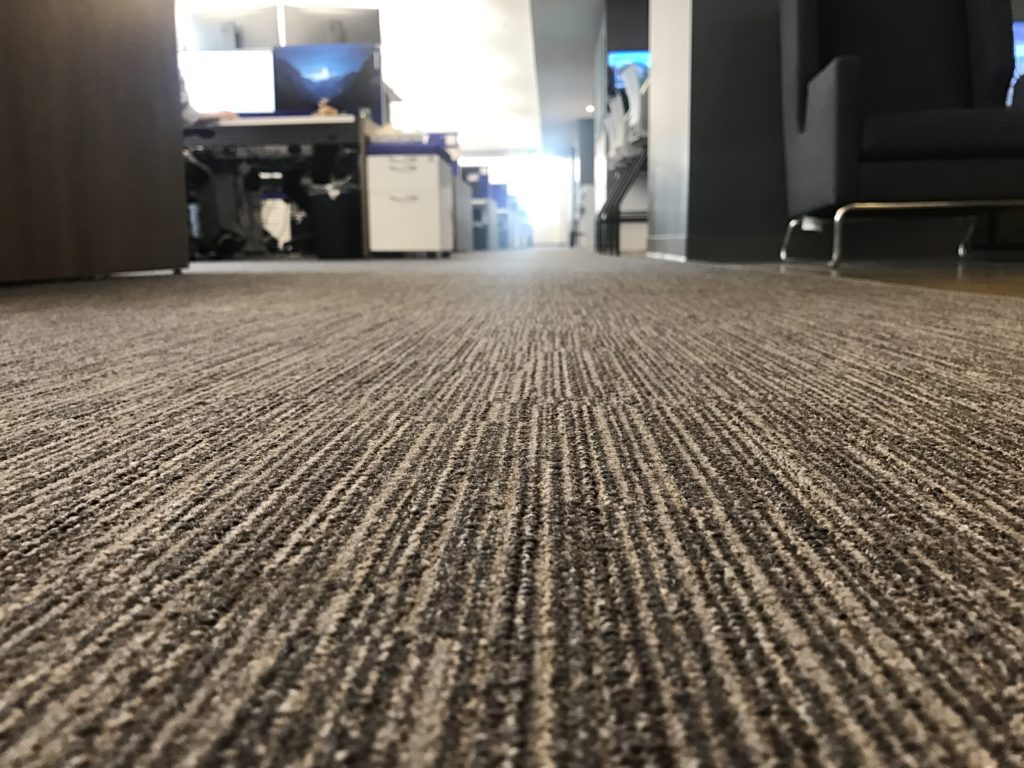What is the best type of carpet for my business?
- The best type of carpet for your business is one that will:
- Hold up to excessive foot traffic.
- Respond well to regular professional cleanings.
- Resist a wide variety of stains.
- Fit your budget, giving you the best quality for the lowest price.
As a building manager or a business owner, a lot of responsibilities fall on your shoulders.
One of the most costly is the decision to replace the carpet in your building or office.
There are a lot of details to consider and it may surprise you to find out that price isn’t the most important variable.
Before you start shopping for the best type of carpet for your business, it’s a good idea to gather some information so you can make the right choice.
Here’s what you need to know.
Get acquainted with carpet types
Replacing the carpet in your business isn’t cheap.
The material itself is costly, but it’s the other associated charges that may be a surprise.
The old carpet needs to be removed, the new carpet has to be installed, and you may even be charged if the installation team has to move the furniture.
All of this might have you thinking that your best option is whatever type of carpet costs the least.
But there’s much more to the decisions than that.
Do you want to pay more up-front to have carpet that lasts longer, looks better, and doesn’t get matted and worn?
And what about clean-ability? The best type of carpet will also be easy to clean and fare much better when it gets regular professional cleanings.
The bottom line is that you have plenty of options when you’re purchasing carpet for your business and they aren’t all the fun decisions, like colors, patterns and textures.
It’s important to think about the best type of carpet fiber in terms of how durable it is and how easy it is to keep clean.
So, what type of carpet fiber is right for your business?
Get educated with the pros and cons of each carpet-fiber type.
1. Acrylic fiber
Acrylic fiber is man-made fiber. It’s manufactured to resemble the look of wool for a much lower price tag.
Pros of Acrylic
-
- Acrylic carpet is significantly less expensive than wool. Sometimes wool and acrylic are blended, which helps the acrylic to last longer and wear better than when it’s by itself. Plus, it’s still more economical than wool.
- Acrylic resists electricity, so you won’t have to worry about getting a shock when you walk across the floor.
- It comes in a variety of brilliant, fade-resistant colors.
- A huge pro for those with allergies, acrylic carpet fiber is hypoallergenic.
- It resists mold and holds in warmth.
Cons of acrylic
-
- Grease, dirt, and other soil can remain embedded in the fibers forever if they’re not cleaned up right away.
- Acrylic has a reputation for losing fibers. This is a big issue for the areas of carpet that see a lot of traffic.
- This carpet fiber only has a lifespan of 5-6 years.If your office is a busy one it could be reduced to 3-5 years.
- Acrylic needs to be treated with a fire-retardant to avoid being ignited because it will flame quickly.
2. Olefin or polypropylene
Also known as Herculean or polypropylene, olefin is a man-made synthetic fiber. It can have two different looks: low-luster (resembling wool) or it can have a higher shine..
Pros of olefin or polypropylene
This is the cheapest carpet fiber you can buy.
It’s stain-resistant.
The fibers won’t be damaged by bleach.
Olefin is very easy to clean, requiring only detergent and warm water.
Cons of olefin/polypropylene
It doesn’t do well in areas that see a lot of foot-traffic.
Olefin fibers are easily crushed and don’t regain their look after a professional cleaning.
While olefin repels dirt, it is still susceptible to grease stains, like those that could be tracked in from the parking lot.
It doesn’t cost much, but remember, you get what you pay for. In this case, a carpet that will only last 3-5 years in a busy place of business.
3. Polyester
In the image above, you’ll see an example of polyester carpet fiber that has been manufactured in a cut/loop pile.
Made from 100% recycled material, polyester also comes in a cut-pile or looped.
Pros of polyester
-
- Polyester carpet is green, thanks to its origin: 100% recycled plastics.
- It’s warm, soft, and feels good on your feet when you walk on it.
- It’s incredibly stain-resistant. You can spill your coffee on it, and, as long as it’s wiped up right away, no one will ever know it happened.
- Polyester carpet fiber comes in an array of colors.
- While it isn’t as inexpensive as acrylic or olefin, it does cost less than nylon.
Cons of polyester
-
- Polyester will still carry a stain from anything oil-based.
- It’s not very durable, so it may not be the best type of carpet for an office or business.
- Polyester fiber crushes and mats easily. This isn’t the look you want to attract customers! It also doesn’t recover well after being professionally cleaned.
- Polyester won’t last more than 5 years, which means you’ll probably have to replace it before you’d like.
4. Nylon
Not only is nylon fiber the most popular for carpet, but it was also the first man-made fiber.
Here’s a little fact you probably didn’t know: Nylon was used to make fishing nets, women’s stockings, and toothbrushes circa 1935. After that, Wallace Hume Carothers turned it into a carpet fiber.
Pros of nylon
-
- Though other man-made fibers don’t resist grease stains, nylon does.
- Nylon is simple to maintain. Most spots can be taken care of with some warm water and a little dish detergent.
- Nylon carpet is usually given longer warranties by the manufacturers.
- When the heat of a truck-mounted thermal extraction cleaning is applied, the fibers “bounce back” where traffic patterns were.
- Nylon carpet has a long lifespan, typically up to 10 years with proper professional maintenance.
Cons of nylon
-
- If you use a spot cleaner that contains bleach, it will leave a mark on the carpet fibers.
- It costs less than wool, but polyester is still the most expensive synthetic fiber.
- It’s susceptible to fading from the sun.
5. Wool
We’ll assume you know where wool comes from. If not, your friend Google can help!
Obviously, it’s a natural fiber but it isn’t the only one. (Sisal and jute are the others.)
Pros of wool
-
- It doesn’t contain any chemicals and it’s hypoallergenic. You should note, however, that sometimes the backing of the carpet may contain latex. Most of the time, the backs of wool rugs are made from jute.
- Wool is biodegradable and environmentally-friendly.
- You (and the sheep) will be happy to find out that wool absorbs moisture. It can soak up 30% of its own weight in moisture. It’s like a built-in dehumidifier. As if that wasn’t enough, wool also takes harmful chemicals out of the air. Way to go, sheep!
- Sheep are able to stay warm in the rain because their wool has a protectant that repels water. But it also repels dirt, stains, and other grimy stuff. For this reason, the best type of carpet fiber to clean is clearly wool.
- Wool feels warm and luxurious. You’ll know this already if you’ve ever petted one.
- You won’t have to worry about replacing your business’ wool carpet because it’s worn out. You’ll almost likely want to update the look before it gets worn.
Cons of wool
-
- New wool carpeting is prone to shedding, though you might not realize it until you change out your vacuum bag!.
- Alkaline cleaners that you can buy in your local hardware store will damage your wool carpet. You’ll want to get in touch with the carpet manufacturer or the professional carpet cleaning company you trust most (*Ahem* Hammond Knoll!) to get suggestions for safe cleaning products.
- Your wool carpet is no match for bleach or the sunshine. Be careful as the color can fade and the fibers can be bleached.
- Of all your options for carpet fiber, wool is the most expensive. But, as we’ve already said, you get what you pay for.
The bottom line on what type of carpet is best
Nylon and wool are both excellent choices if your goal is to have carpet that’s durable and easy-to-clean.
If you’re being cost-conscious, nylon is less expensive and still a quality choice.
Wool is the best type of carpet for you if your main goal is longevity, wearability and simple maintenance.
But, ultimately, the choice is yours! Do you want to save money now on a cheaper option and have to replace it in a few years?
Or do you want to spend more up-front to save in the long-run?
No matter what type of carpet you choose, you need to remember that all carpets need to be cleaned by professionals to have a longer life, maintain a healthy environment, and make your business look great.

